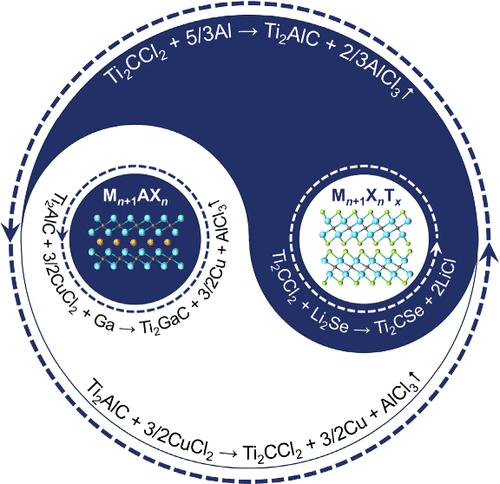当前位置:
X-MOL 学术
›
Acc. Mater. Res.
›
论文详情
Our official English website, www.x-mol.net, welcomes your
feedback! (Note: you will need to create a separate account there.)
Layered Transition Metal Carbides/Nitrides: From Chemical Etching to Chemical Editing
Accounts of Materials Research ( IF 14.0 ) Pub Date : 2024-11-19 , DOI: 10.1021/accountsmr.4c00250 Haoming Ding, Youbing Li, Mian Li, Zhifang Chai, Qing Huang
Accounts of Materials Research ( IF 14.0 ) Pub Date : 2024-11-19 , DOI: 10.1021/accountsmr.4c00250 Haoming Ding, Youbing Li, Mian Li, Zhifang Chai, Qing Huang

|
Topotactic transformations between related crystal structures, involving etching, replacement, and intercalation, are increasingly recognized in the design and tuning of material properties. These transformations reveal the fundamental principles of material structural changes, paving the way for creating novel materials with unique properties. Layered materials readily undergo structural or compositional changes due to their stacked atomic layers and bonding features. MAX phases, as nonvan der Waals (non-vdW) layered compounds, exhibit distinctive elemental compositions and bonding characters that make them suitable for topotactic transformations. A notable example is the typical transformation from MAX phases to MXenes, a new addition to two-dimensional (2D) materials, through A-site etching within MAX phases. In turn, the 2D structure of MXenes further promoted versatile topotactic transformations utilizing the interlayer space and tunable surfaces. This Account comprehensively reviews the topotactic transformation in MXenes and MAX phases, covering aspects from chemical etching to versatile chemical editing. We commence with an analysis of MAX phase degradation, examining the corrosion resistance of MAX phases in liquid metals and molten salts, which is crucial for their application as nuclear materials. This leads us to introduce the novel concept of precise A-site etching in MAX phases, which has paved the way for the groundbreaking discovery of 2D MXene. Given the important effect of etching methods on MXenes, we then delve into the various etching methods employed in preparing MXene and explore the detailed processes and mechanisms behind each method. Additionally, we highlight the recent advancements made by our research group regarding the Lewis acidic molten salt (LAMS) method. This method utilizes LAMSs as etching agents to selectively etch the A-site atomic layer, creating opportunities for the subsequent intercalation of atoms or anions to achieve isomorphous replacement of A-site atoms and surface modification with novel terminations. The strong oxidation ability of LAMSs also offers versatility in selectively etching A-site atomic species, particularly confined to the Al element. The LAMS method shows potential for synthesizing and controlling the structure of MXene and MAX phases, albeit with limitations. Its success depends on the properties of LAMSs, which must facilitate both etching and intercalation. However, some LAMSs are unsuitable due to their low redox potential, low boiling points, and instability at high temperatures. Therefore, we propose a versatile chemical scissor-mediated structural editing strategy. This strategy decouples etching from intercalation, using Lewis acidic cations or reduced metal atoms as chemical scissors to create space between MX sublayers, allowing atoms or anions to diffuse and enable topotactic transitions. This approach has facilitated the intercalation of various A-site atoms, expanded MXene surface termination options, and even enabled the conversion of 2D MXene into 3D MAX phases by combining termination removal with atom intercalation. Finally, we offer insights into the future of topotactic transformations in these materials, aiming to inspire further innovative progress in this field. A deeper understanding of the topotactic transformation process holds the promise of broadening the applications of layered materials, providing a solid foundation for advancements in related areas.
中文翻译:

层状过渡金属碳化物/氮化物:从化学蚀刻到化学编辑
相关晶体结构之间的拓扑转换,包括蚀刻、替换和插层,在材料特性的设计和调整中越来越得到认可。这些转变揭示了材料结构变化的基本原理,为创造具有独特性能的新型材料铺平了道路。由于层状材料具有堆叠的原子层和键合特性,它们很容易发生结构或成分变化。MAX 相作为非范德华 (non-van-der Waals) 层状化合物,表现出独特的元素组成和键合特性,使其适用于拓扑转变。一个值得注意的例子是通过 MAX 相内的 A 位蚀刻,从 MAX 相到 MXenes 的典型转变,MXenes 是二维 (2D) 材料的新增功能。反过来,MXenes 的 2D 结构进一步促进了利用层间空间和可调表面的多功能拓扑变形。本账户全面回顾了 MXenes 和 MAX 相中的拓扑策略转变,涵盖了从化学刻蚀到多功能化学编辑的各个方面。我们首先分析 MAX 相降解,检查 MAX 相在液态金属和熔盐中的耐腐蚀性,这对于它们作为核材料的应用至关重要。这促使我们引入了 MAX 固定相中精确 A 位蚀刻的新概念,这为 2D MXene 的开创性发现铺平了道路。鉴于刻蚀方法对 MXenes 的重要影响,我们随后深入研究了制备 MXene 所采用的各种刻蚀方法,并探讨了每种方法背后的详细过程和机制。 此外,我们还重点介绍了我们的研究小组在路易斯酸性熔盐 (LAMS) 方法方面取得的最新进展。该方法利用 LAMS 作为蚀刻剂选择性地刻蚀 A 位原子层,为随后的原子或阴离子嵌入创造机会,以实现 A 位原子的同晶置换和具有新颖末端的表面修饰。LAMS 的强氧化能力还为选择性蚀刻 A 位原子种类提供了多功能性,特别是仅限于 Al 元素。LAMS 方法显示出合成和控制 MXene 和 MAX 相结构的潜力,尽管存在局限性。它的成功取决于 LAMS 的特性,而 LAMS 的特性必须有利于蚀刻和插层。然而,一些 LAMS 由于其低氧化还原电位、低沸点和高温下的不稳定性而不适合。因此,我们提出了一种通用的化学剪刀介导的结构编辑策略。这种策略将蚀刻与插层解耦,使用 Lewis 酸性阳离子或还原金属原子作为化学剪刀,在 MX 子层之间创造空间,允许原子或阴离子扩散并实现拓扑转变。这种方法促进了各种 A 位原子的插层,扩展了 MXene 表面端接选项,甚至通过将终止去除与原子插层相结合,实现了将 2D MXene 转换为 3D MAX 相。最后,我们提供了对这些材料拓扑结构转变未来的见解,旨在激发该领域的进一步创新进步。 对拓扑转变过程的更深入理解有望拓宽层状材料的应用,为相关领域的进步奠定坚实的基础。
更新日期:2024-11-20
中文翻译:

层状过渡金属碳化物/氮化物:从化学蚀刻到化学编辑
相关晶体结构之间的拓扑转换,包括蚀刻、替换和插层,在材料特性的设计和调整中越来越得到认可。这些转变揭示了材料结构变化的基本原理,为创造具有独特性能的新型材料铺平了道路。由于层状材料具有堆叠的原子层和键合特性,它们很容易发生结构或成分变化。MAX 相作为非范德华 (non-van-der Waals) 层状化合物,表现出独特的元素组成和键合特性,使其适用于拓扑转变。一个值得注意的例子是通过 MAX 相内的 A 位蚀刻,从 MAX 相到 MXenes 的典型转变,MXenes 是二维 (2D) 材料的新增功能。反过来,MXenes 的 2D 结构进一步促进了利用层间空间和可调表面的多功能拓扑变形。本账户全面回顾了 MXenes 和 MAX 相中的拓扑策略转变,涵盖了从化学刻蚀到多功能化学编辑的各个方面。我们首先分析 MAX 相降解,检查 MAX 相在液态金属和熔盐中的耐腐蚀性,这对于它们作为核材料的应用至关重要。这促使我们引入了 MAX 固定相中精确 A 位蚀刻的新概念,这为 2D MXene 的开创性发现铺平了道路。鉴于刻蚀方法对 MXenes 的重要影响,我们随后深入研究了制备 MXene 所采用的各种刻蚀方法,并探讨了每种方法背后的详细过程和机制。 此外,我们还重点介绍了我们的研究小组在路易斯酸性熔盐 (LAMS) 方法方面取得的最新进展。该方法利用 LAMS 作为蚀刻剂选择性地刻蚀 A 位原子层,为随后的原子或阴离子嵌入创造机会,以实现 A 位原子的同晶置换和具有新颖末端的表面修饰。LAMS 的强氧化能力还为选择性蚀刻 A 位原子种类提供了多功能性,特别是仅限于 Al 元素。LAMS 方法显示出合成和控制 MXene 和 MAX 相结构的潜力,尽管存在局限性。它的成功取决于 LAMS 的特性,而 LAMS 的特性必须有利于蚀刻和插层。然而,一些 LAMS 由于其低氧化还原电位、低沸点和高温下的不稳定性而不适合。因此,我们提出了一种通用的化学剪刀介导的结构编辑策略。这种策略将蚀刻与插层解耦,使用 Lewis 酸性阳离子或还原金属原子作为化学剪刀,在 MX 子层之间创造空间,允许原子或阴离子扩散并实现拓扑转变。这种方法促进了各种 A 位原子的插层,扩展了 MXene 表面端接选项,甚至通过将终止去除与原子插层相结合,实现了将 2D MXene 转换为 3D MAX 相。最后,我们提供了对这些材料拓扑结构转变未来的见解,旨在激发该领域的进一步创新进步。 对拓扑转变过程的更深入理解有望拓宽层状材料的应用,为相关领域的进步奠定坚实的基础。






























 京公网安备 11010802027423号
京公网安备 11010802027423号